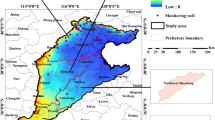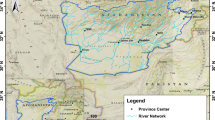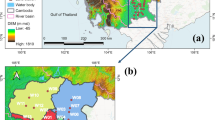Abstract
Droughts frequently occurring in India have significant societal, economic, and environmental effects. The lack of direct measurements of groundwater in location and time hinders quantitative methods to analyse the intricate nature of groundwater drought. This work used the datasets derived from the Gravity and Climate Experiment (GRACE and GRACE-FO) and Global Land Data Assimilation System (GLDAS) to extensively analyse Groundwater Storage changes in the Lower Gangetic Basin (LGB) using unique hydrological parameters between the years 2003 and 2022. The analysis highlights that the GRACE-derived terrestrial water storage anomaly in the LGB decreased significantly (-12.12 mm/yr), and the amount of Groundwater Storage Anomaly (GWSA) decreased similarly (-10.80 mm/yr), while in the GRACE-FO period, a positive trend has been noticed in TWSA (33.96 mm/yr) and GWSA (64.8 mm/yr) respectively. A drought indicator called the GRACE-derived groundwater drought index (GGDI) has been computed for the entire LGB region. A traditional drought study viz. Standardised Precipitation Index (SPI) was performed over LGB to justify the results of the GGDI. The results from GGDI study effectively matched the periods of significant drought occurrences with the 12-month SPI time series. From the GGDI, this study examined groundwater drought’s spatial distribution, temporal evolution, and trend (Modified Mann Kendall trend) aspects. According to research findings, the LGB experienced three major drought periods between 2009–2010, 2019 (moderate), and 2015–2016 (severe). The study offers reliable quantitative data on the evolution of GRACE-derived groundwater drought, which may add a new perspective to additional drought research in the densely populated study area, which depends majorly on agriculture, livestock and less skilled water-intensive industries such as leather and textile industries in a sub-tropical climate. This paradigm incorporates changes in groundwater resources caused by human activities and climate change, paving the way for measuring progress towards sustainable use and water security.










Similar content being viewed by others
Data availability
GRACE data is freely available from the NASA Jet Propulsion Laboratory website https://podaac.jpl.nasa.gov/GRACE. GLDAS LSM model data were available from the GIOVANNI website https://giovanni.gsfc.nasa.gov/giovanni/. Precipitation data is freely available from the website of IMD Pune, https://www.imdpune.gov.in/.
Code availability
The authors are not willing to disclose the developed codes utilised in this study.
References
Agboma, C. O., Yirdaw, S. Z., & Snelgrove, K. R. (2009). Intercomparison of the total storage deficit index (TSDI) over two Canadian Prairie catchments. Journal of Hydrology, 374(3–4), 351–359. https://doi.org/10.1016/j.jhydrol.2009.06.034
Ali, S., Wang, Q., Liu, D., Fu, Q., Mafuzur Rahaman, M., Abrar Faiz, M., Cheema, J. M., & M. (2022). Estimation of spatio-temporal groundwater storage variations in the Lower Transboundary Indus Basin using GRACE satellite. Journal of Hydrology, 605. https://doi.org/10.1016/j.jhydrol.2021.127315
Bloomfield, J. P., & Marchant, B. P. (2013). Analysis of groundwater drought building on the standardised precipitation index approach. Hydrology and Earth System Sciences, 17(12), 4769–4787. https://doi.org/10.5194/hess-17-4769-2013
Cammalleri, C., Vogt, J. V., Bisselink, B., & De Roo, A. (2017). Comparing soil moisture anomalies from multiple independent sources over different regions across the globe. Hydrology and Earth System Sciences, 21(12), 6329–6343. https://doi.org/10.5194/hess-21-6329-2017
Dangar, S., & Mishra, V. (2021). Natural and anthropogenic drivers of the lost groundwater from the Ganga River basin. Environmental Research Letters, 16(11). https://doi.org/10.1088/1748-9326/ac2ceb
Dutt Vishwakarma, B., Jain, K., Sneeuw, N., & Devaraju, B. (2013). Mumbai 2005, Bihar 2008 Flood Reflected in Mass Changes Seen by GRACE Satellites. Journal of the Indian Society of Remote Sensing, 41(3), 687–695. https://doi.org/10.1007/s12524-012-0256-x
Famiglietti, J. S., Lo, M., Ho, S. L., Bethune, J., Anderson, K. J., Syed, T. H., et al. (2011). Satellites measure recent rates of groundwater depletion in California’s Central Valley. Geophysical Research Letters, 38(3). https://doi.org/10.1029/2010GL046442
Famiglietti, J. S., & Rodell, M. (2013). Water in the balance. Science. American Association for the Advancement of Science. https://doi.org/10.1126/science.1236460
FAO. (2021). The State of Food and Agriculture 2021. The State of Food and Agriculture 2021. Food and Agriculture Organization. https://doi.org/10.4060/cb4476en
Faunt, C. C., Sneed, M., Traum, J., & Brandt, J. T. (2016). Water availability and land subsidence in the Central Valley, California, USA. Hydrogeology Journal, 24(3), 675–684. https://doi.org/10.1007/s10040-015-1339-x
Feng, W., Zhong, M., Lemoine, J. M., Biancale, R., Hsu, H. T., & Xia, J. (2013). Evaluation of groundwater depletion in North China using the Gravity Recovery and Climate Experiment (GRACE) data and ground-based measurements. Water Resources Research, 49(4), 2110–2118. https://doi.org/10.1002/wrcr.20192
Forootan, E., Khaki, M., Schumacher, M., Wulfmeyer, V., Mehrnegar, N., van Dijk, A. I. J. M., et al. (2019). Understanding the global hydrological droughts of 2003–2016 and their relationships with teleconnections. Science of the Total Environment, 650, 2587–2604. https://doi.org/10.1016/j.scitotenv.2018.09.231
Ghosh, K. G. (2018). Analysis of Rainfall Trends and its Spatial Patterns During the Last Century over the Gangetic West Bengal, Eastern India. Journal of Geovisualization and Spatial Analysis, 2(2). https://doi.org/10.1007/s41651-018-0022-x
Girotto, M., De Lannoy, G. J. M., Reichle, R. H., Rodell, M., Draper, C., Bhanja, S. N., & Mukherjee, A. (2017). Benefits and pitfalls of GRACE data assimilation: A case study of terrestrial water storage depletion in India. Geophysical Research Letters, 44(9), 4107–4115. https://doi.org/10.1002/2017GL072994
Gleeson, T., Wada, Y., Bierkens, M. F. P., & Van Beek, L. P. H. (2012). Water balance of global aquifers revealed by groundwater footprint. Nature, 488(7410), 197–200. https://doi.org/10.1038/nature11295
Hamed, K. H., & Rao, A. R. (1998). A modified Mann-Kendall trend test for autocorrelated data. Journal of Hydrology, 204(1–4), 182–196. https://doi.org/10.1016/S0022-1694(97)00125-X
Han, Z., Huang, S., Huang, Q., Leng, G., Liu, Y., Bai, Q., et al. (2021). GRACE-based high-resolution propagation threshold from meteorological to groundwater drought. Agricultural and Forest Meteorology, 307. https://doi.org/10.1016/j.agrformet.2021.108476
Hosseini-Moghari, S. M., Araghinejad, S., Ebrahimi, K., Tang, Q., & AghaKouchak, A. (2020). Using GRACE satellite observations for separating meteorological variability from anthropogenic impacts on water availability. Scientific Reports, 10(1). https://doi.org/10.1038/s41598-020-71837-7
Hosseini-Moghari, S. M., Araghinejad, S., Ebrahimi, K., & Tourian, M. J. (2019). Introducing modified total storage deficit index (MTSDI) for drought monitoring using GRACE observations. Ecological Indicators, 101, 465–475. https://doi.org/10.1016/j.ecolind.2019.01.002
Houborg, R., Rodell, M., Li, B., Reichle, R., & Zaitchik, B. F. (2012). Drought indicators based on model-assimilated Gravity Recovery and Climate Experiment (GRACE) terrestrial water storage observations. Water Resources Research, 48(7). https://doi.org/10.1029/2011WR011291
Huang, S., Huang, Q., Zhang, H., Chen, Y., & Leng, G. (2016). Spatio-temporal changes in precipitation, temperature and their possibly changing relationship: A case study in the Wei River Basin, China. International Journal of Climatology, 36(3), 1160–1169. https://doi.org/10.1002/joc.4409
Jasechko, S., Birks, S. J., Gleeson, T., Wada, Y., Fawcett, P. J., Sharp, Z. D., et al. (2014). The pronounced seasonality of global groundwater recharge. Water Resources Research, 50(11), 8845–8867. https://doi.org/10.1002/2014WR015809
Jha, R., Mondal, A., Devanand, A., Roxy, M. K., & Ghosh, S. (2022). Limited influence of irrigation on pre-monsoon heat stress in the Indo-Gangetic Plain. Nature Communications, 13(1). https://doi.org/10.1038/s41467-022-31962-5
Jiang, W., Ji, X., Li, Y., Luo, X., Yang, L., Ming, W., et al. (2023). Modified flood potential index (MFPI) for flood monitoring in terrestrial water storage depletion basin using GRACE estimates. Journal of Hydrology, 616. https://doi.org/10.1016/j.jhydrol.2022.128765
Kang, H., & Sridhar, V. (2017a). Combined statistical and spatially distributed hydrological model for evaluating future drought indices in Virginia. Journal of Hydrology: Regional Studies, 12, 253–272. https://doi.org/10.1016/j.ejrh.2017.06.003
Kang, H., & Sridhar, V. (2017b). Description of future drought indices in Virginia. Data in Brief, 14, 278–290. https://doi.org/10.1016/j.dib.2017.07.042
Kang, H., & Sridhar, V. (2018). Assessment of Future Drought Conditions in the Chesapeake Bay Watershed. Journal of the American Water Resources Association, 54(1), 160–183. https://doi.org/10.1111/1752-1688.12600
Katpatal, Y. B., Rishma, C., & Singh, C. K. (2018). Sensitivity of the Gravity Recovery and Climate Experiment (GRACE) to the complexity of aquifer systems for monitoring of groundwater. Hydrogeology Journal, 26(3), 933–943. https://doi.org/10.1007/s10040-017-1686-x
Kvas, A., Behzadpour, S., Ellmer, M., Klinger, B., Strasser, S., Zehentner, N., & Mayer-Gürr, T. (2019). ITSG-Grace2018: Overview and Evaluation of a New GRACE-Only Gravity Field Time Series. Journal of Geophysical Research: Solid Earth, 124(8), 9332–9344. https://doi.org/10.1029/2019JB017415
Landerer, F. W., & Swenson, S. C. (2012). Accuracy of scaled GRACE terrestrial water storage estimates. Water Resources Research, 48(4). https://doi.org/10.1029/2011WR011453
Liu, X., Feng, X., Ciais, P., Fu, B., Hu, B., & Sun, Z. (2020). GRACE satellite-based drought index indicating increased impact of drought over major basins in China during 2002–2017. Agricultural and Forest Meteorology, 291. https://doi.org/10.1016/j.agrformet.2020.108057
Long, D., Longuevergne, L., & Scanlon, B. R. (2015). Global analysis of approaches for deriving total water storage changes from GRACE satellites. Water Resources Research, 51(4), 2574–2594. https://doi.org/10.1002/2014WR016853
Long, D., Scanlon, B. R., Longuevergne, L., Sun, A. Y., Fernando, D. N., & Save, H. (2013). GRACE satellite monitoring of large depletion in water storage in response to the 2011 drought in Texas. Geophysical Research Letters, 40(13), 3395–3401. https://doi.org/10.1002/grl.50655
Long, D., Shen, Y., Sun, A., Hong, Y., Longuevergne, L., Yang, Y., et al. (2014). Drought and flood monitoring for a large karst plateau in Southwest China using extended GRACE data. Remote Sensing of Environment, 155, 145–160. https://doi.org/10.1016/j.rse.2014.08.006
MacDonald, A. M., Bonsor, H. C., Ahmed, K. M., Burgess, W. G., Basharat, M., Calow, R. C., et al. (2016). Groundwater quality and depletion in the Indo-Gangetic Basin mapped from in situ observations. Nature Geoscience, 9(10), 762–766. https://doi.org/10.1038/ngeo2791
Mckee, T. B., Doesken, N. J., & Kleist, J. (1993, January). The relationship of drought frequency and duration to time scales. In Proceedings of the 8th Conference on Applied Climatology (Vol. 17, No. 22, pp. 179–183). https://climate.colostate.edu/pdfs/relationshipofdroughtfrequency.pdf
Mishra, A. K., & Singh, V. P. (2010, September). A review of drought concepts. Journal of Hydrology. https://doi.org/10.1016/j.jhydrol.2010.07.012
Mishra, A. K., & Singh, V. P. (2011). Drought modeling - A review. Journal of Hydrology. https://doi.org/10.1016/j.jhydrol.2011.03.049
Mishra, V., Aadhar, S., Asoka, A., Pai, S., & Kumar, R. (2016). On the frequency of the 2015 monsoon season drought in the Indo-Gangetic Plain. Geophysical Research Letters, 43(23), 12,102–12,112. https://doi.org/10.1002/2016GL071407
Mondal, I., Srivastava, V. K., Roy, P. S., & Talukdar, G. (2014). Using logit model to identify the drivers of landuse landcover change in the lower gangetic basin, India. In International Archives of the Photogrammetry, Remote Sensing and Spatial Information Sciences - ISPRS Archives (Vol. XL–8, pp. 853–859). International Society for Photogrammetry and Remote Sensing. https://doi.org/10.5194/isprsarchives-XL-8-853-2014
Pal, D. K., Bhattacharyya, T., Srivastava, P., Chandran, P., & Ray, S. K. (2009). Current Science Association Soils of the Indo-Gangetic Plains: their historical perspective and management. Source: Current Science (96). https://www.jstor.org/stable/24105408
Parajuli, B., Zhang, X., Deuja, S., & Liu, Y. (2021). Regional and seasonal precipitation and drought trends in ganga-brahmaputra basin. Water (Switzerland), 13(16). https://doi.org/10.3390/w13162218
Rahaman, M. H., Saha, T. K., Masroor, M., & Roshani, & Sajjad, H. (2023). Trend analysis and forecasting of meteorological variables in the lower Thoubal river watershed, India using non-parametrical approach and machine learning models. Modeling Earth Systems and Environment. https://doi.org/10.1007/s40808-023-01799-y
Ramillien, G., Famiglietti, J. S., & Wahr, J. (2008). Detection of continental hydrology and glaciology Signals from GRACE: A review. Surveys in Geophysics. https://doi.org/10.1007/s10712-008-9048-9
Rawat, S., Ganapathy, A., & Agarwal, A. (2022). Drought characterization over Indian sub-continent using GRACE-based indices. Scientific Reports, 12(1). https://doi.org/10.1038/s41598-022-18511-2
Reager, J. T., & Famiglietti, J. S. (2013). Characteristic mega-basin water storage behavior using GRACE. Water Resources Research, 49(6), 3314–3329. https://doi.org/10.1002/wrcr.20264
Rodell, M., & Famiglietti, J. S. (2002). The potential for satellite-based monitoring of groundwater storage changes using GRACE: the High Plains aquifer, Central US. Journal of Hydrology, 263(1–4), 245–256. https://doi.org/10.1016/S0022-1694(02)00060-4
Rodell, M., Famiglietti, J. S., Chen, J., Seneviratne, S. I., Viterbo, P., Holl, S., & Wilson, C. R. (2004). Basin scale estimates of evapotranspiration using GRACE and other observations. Geophysical Research Letters, 31(20). https://doi.org/10.1029/2004GL020873
Rodell, M., Velicogna, I., & Famiglietti, J. S. (2009). Satellite-based estimates of groundwater depletion in India. Nature, 460(7258), 999–1002. https://doi.org/10.1038/nature08238
Rowlands, D. D., Luthcke, S. B., Klosko, S. M., Lemoine, F. G. R., Chinn, D. S., McCarthy, J. J., et al. (2005). Resolving mass flux at high spatial and temporal resolution using GRACE intersatellite measurements. Geophysical Research Letters, 32(4), 1–4. https://doi.org/10.1029/2004GL021908
Sa’adi, Z., Shahid, S., Ismail, T., Chung, E. S., & Wang, X. J. (2019). Trends analysis of rainfall and rainfall extremes in Sarawak, Malaysia using modified Mann–Kendall test. Meteorology and Atmospheric Physics, 131(3), 263–277. https://doi.org/10.1007/s00703-017-0564-3
Sahoo, A. K., Sheffield, J., Pan, M., & Wood, E. F. (2015). Evaluation of the Tropical Rainfall Measuring Mission Multi-Satellite Precipitation Analysis (TMPA) for assessment of large-scale meteorological drought. Remote Sensing of Environment, 159, 181–193. https://doi.org/10.1016/j.rse.2014.11.032
Saxena, S., Rabha, A., Tahlani, P., & Ray, S. S. (2021). Crop Situation in India, Before, During and After COVID-19 Lockdown, as Seen from the Satellite Data of Resourcesat-2 AWiFS. Journal of the Indian Society of Remote Sensing, 49(2), 365–376. https://doi.org/10.1007/s12524-020-01213-5
Scanlon, B. R., Zhang, Z., Rateb, A., Sun, A., Wiese, D., Save, H., et al. (2019). Tracking Seasonal Fluctuations in Land Water Storage Using Global Models and GRACE Satellites. Geophysical Research Letters, 46(10), 5254–5264. https://doi.org/10.1029/2018GL081836
Scanlon, B. R., Zhang, Z., Save, H., Wiese, D. N., Landerer, F. W., Long, D., et al. (2016). Global evaluation of new GRACE mascon products for hydrologic applications. Water Resources Research, 52(12), 9412–9429. https://doi.org/10.1002/2016WR019494
Sehgal, V. K., Singh, M. R., Chaudhary, A., Jain, N., & Pathak, H. (2013). Vulnerability of Agriculture to Climate Change: District Level Assessment in the Indo-Gangetic Plains. https://www.researchgate.net/profile/Vinay-Sehgal/publication/292575090_Vulnerability_of_the_Indo-Gangetic_Plains_to_climate_change/links/5aab79120f7e9b88267183ae/Vulnerability-of-the-Indo-Gangetic-Plainsto-climate-change.pdf
Singh, C. V. (1998). Long term estimation of monsoon rainfall using stochastic models. International Journal of Climatology, 18(14), 1611–1624. https://doi.org/10.1002/(SICI)1097-0088(19981130)18:14<1611::AID-JOC333>3.0.CO;2-F
Sinha, D., Syed, T. H., & Reager, J. T. (2019). Utilizing combined deviations of precipitation and GRACE-based terrestrial water storage as a metric for drought characterization: A case study over major Indian river basins. Journal of Hydrology, 572, 294–307. https://doi.org/10.1016/j.jhydrol.2019.02.053
Srivastava, A. K., Rajeevan, M., & Kshirsagar, S. R. (2009). Development of a high resolution daily gridded temperature data set (1969-2005) for the Indian region. Atmospheric Science Letters, 10(4), 249–254. https://doi.org/10.1002/asl.232
Sturchio, N. C., Du, X., Purtschert, R., Lehmann, B. E., Sultan, M., Patterson, L. J., et al. (2004). One million year old groundwater in the Sahara revealed by krypton-81 and chlorine-36. Geophysical Research Letters, 31(5). https://doi.org/10.1029/2003GL019234
Sun, Z., Zhu, X., Pan, Y., Zhang, J., & Liu, X. (2018). Drought evaluation using the GRACE terrestrial water storage deficit over the Yangtze River Basin, China. Science of the Total Environment, 634, 727–738. https://doi.org/10.1016/j.scitotenv.2018.03.292
Thomas, A. C., Reager, J. T., Famiglietti, J. S., & Rodell, M. (2014a). A GRACE-based water storage deficit approach for hydrological drought characterization. Geophysical Research Letters, 41(5), 1537–1545. https://doi.org/10.1002/2014GL059323
Thomas, A. C., Reager, J. T., Famiglietti, J. S., & Rodell, M. (2014b). A GRACE-based water storage deficit approach for hydrological drought characterization. Geophysical Research Letters, 41(5), 1537–1545. https://doi.org/10.1002/2014GL059323
Thomas, B. F., Famiglietti, J. S., Landerer, F. W., Wiese, D. N., Molotch, N. P., & Argus, D. F. (2017). GRACE groundwater drought index: Evaluation of California Central Valley groundwater drought. Remote Sensing of Environment, 198, 384–392. https://doi.org/10.1016/j.rse.2017.06.026
UNESCO. (2023). Partnerships and cooperation for water The United Nations World Water Development Report 2023 Executive Summary. https://unesdoc.unesco.org/ark:/48223/pf0000384657. Accessed 11 December 2023
Van Lanen, H. A., & Peters, E. (2000). Definition, effects and assessment of groundwater droughts. In Drought and drought mitigation in Europe (pp. 49–61). Dordrecht: Springer Netherlands. https://doi.org/10.1007/978-94-015-9472-1_4
Verma, K., & Katpatal, Y. B. (2020). Groundwater Monitoring Using GRACE and GLDAS Data after Downscaling Within Basaltic Aquifer System. Groundwater, 58(1), 143–151. https://doi.org/10.1111/gwat.12929
Wang, F., Wang, Z., Yang, H., Di, D., Zhao, Y., & Liang, Q. (2020). Utilizing GRACE-based groundwater drought index for drought characterization and teleconnection factors analysis in the North China Plain. Journal of Hydrology, 585. https://doi.org/10.1016/j.jhydrol.2020.124849
Wilhite, D. A., Svoboda, M. D., & Hayes, M. J. (2007). Understanding the complex impacts of drought: A key to enhancing drought mitigation and preparedness. Water Resources Management, 21(5), 763–774. https://doi.org/10.1007/s11269-006-9076-5
World Bank. (2021). Independent Evaluation Group (IEG) Implementation Completion Report (ICR) Review IN: National Ganga River Basin Project (P119085) Country Practice Area(Lead) L/C/TF Number(s) Closing Date (Original) Total Project Cost (USD) Bank Approval Date Closing Date (Actual). https://projects.worldbank.org/en/projects-operations/project-detail/P119085?lang=en. Accessed 12 December 2023
Yi, H., & Wen, L. (2016). Satellite gravity measurement monitoring terrestrial water storage change and drought in the continental United States. Scientific Reports, 6. https://doi.org/10.1038/srep19909
Yirdaw, S. Z., Snelgrove, K. R., & Agboma, C. O. (2008). GRACE satellite observations of terrestrial moisture changes for drought characterization in the Canadian Prairie. Journal of Hydrology, 356(1–2), 84–92. https://doi.org/10.1016/j.jhydrol.2008.04.004
Yuan, X., Wang, L., Wu, P., Ji, P., Sheffield, J., & Zhang, M. (2019). Anthropogenic shift towards higher risk of flash drought over China. Nature Communications, 10(1). https://doi.org/10.1038/s41467-019-12692-7
Zhao, M., Kimball, J. S. A. G., & Velicogna, I. (2017a). Satellite Observations of Regional Drought Severity in the Continental United States Using GRACE-Based Terrestrial Water Storage Changes. Journal of Climate. https://doi.org/10.1175/JCLI-D-16-0458.s1
Zhao, M., Kimball, J. S. A. G., & Velicogna, I. (2017b). A Global Gridded Dataset of GRACE Drought Severity Index for 2002-14: Comparison with PDSI and SPEI and a Case Study of the Australia Millennium Drought. Journal of Hydrometeorology. https://doi.org/10.1175/JHM-D-16-0182.s1
Author information
Authors and Affiliations
Contributions
SN formulated the problem, collected and assimilated the data, prepared the methodology, developed the codes, conducted the statistical analysis, and prepared the original draft. SB contributed to the inception of the research idea, editing the manuscript and supervising.
All authors have read, understood, and have complied as applicable with the statement on “Ethical responsibilities of Authors” as found in the Instructions for Authors.
Corresponding author
Ethics declarations
Ethics approval
Not applicable to the current study.
Consent to participate
The authors express their consent to participate in the research and review.
Consent for publication
The authors express their consent for the publication of research work.
Conflict of interest
The authors declare no competing interests.
Additional information
Publisher’s Note
Springer Nature remains neutral with regard to jurisdictional claims in published maps and institutional affiliations.
Rights and permissions
Springer Nature or its licensor (e.g. a society or other partner) holds exclusive rights to this article under a publishing agreement with the author(s) or other rightsholder(s); author self-archiving of the accepted manuscript version of this article is solely governed by the terms of such publishing agreement and applicable law.
About this article
Cite this article
Nandi, S., Biswas, S. Spatiotemporal distribution of groundwater drought using GRACE-based satellite estimates: a case study of Lower Gangetic Basin, India. Environ Monit Assess 196, 151 (2024). https://doi.org/10.1007/s10661-024-12309-7
Received:
Accepted:
Published:
DOI: https://doi.org/10.1007/s10661-024-12309-7




